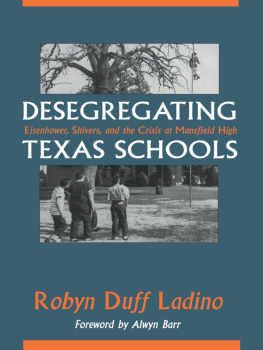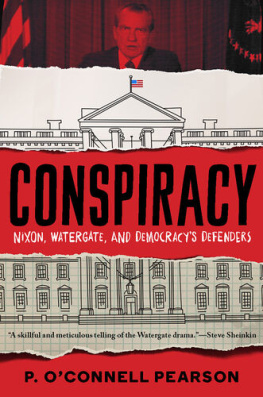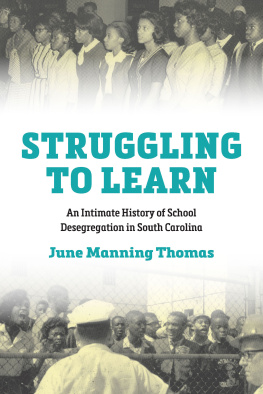Effigy hung from the flagpole at Mansfield High School on Thursday, August 30, 1956. The figure remained in place until September 4. Another effigy, hung on August 31, remained above the schools main entrance for several more days.
DESEGREGATING TEXAS SCHOOLS:
Eisenhower, Shivers, and the Crisis at Mansfield High
Robyn Duff Ladino
 UNIVERSITY OF TEXAS PRESS, AUSTIN
UNIVERSITY OF TEXAS PRESS, AUSTINCover photo/frontispiece courtesy of Fort Worth Star-Telegram
Photograph Collection, Special Collections Division,
The University of Texas at Arlington Libraries.
Copyright 1996 by the University of Texas Press
All rights reserved
Printed in the United States of America
First edition, 1996
Requests for permission to reproduce material from this work should be sent to Permissions, University of Texas Press,
P.O. Box 7819, Austin, TX 78713-7819.
utpress.utexas.edu/index.php/rp-form
Library of Congress Cataloging-in-Publication Data
Library ebook ISBN: 978-0-292-79967-7
Individual ebook ISBN: 9780292799677
DOI: 10.7560/746916
Ladino, Robyn Duff, 1954
Desegregating Texas schools : Eisenhower, Shivers, and the crisis at Mansfield High / Robyn Duff Ladino. 1st ed.
p. cm.
Includes bibliographical references and index.
ISBN 0-292-74692-X
1. School integrationUnited StatesCase studies. 2. School integrationTexasCase studies. 3. Mansfield High School (Mansfield, Tex.). 4. Shivers, Allan, 19075. Eisenhower, Dwight D. (Dwight David), 18901969. I. Title.
LC214.2.L33 1996
370.19'342dc20
96-12112
This book is dedicated to my loving family, Tony, Marie, and Beth.
Contents
by Alwyn Barr
This study of the Mansfield, Texas, school desegregation crisis in 1956 fills an important niche in the history of the civil rights movement and in the history of southern public education. By exploring carefully the relationship between school desegregation and politics, both state and national, the author helps explain the slow progress in integrating public education during the years immediately after the Brown decisions. That analysis of the politics of school desegregation clarifies why Mansfield, despite a failure to desegregate, did not become a focal point of national attention and debate as did Little Rock, Arkansas, in the following year.
From reading this account of events in Mansfield and those related to its school desegregation case, one is also reminded of the important role states of the Border South played in the early efforts to integrate public education. Too often the later struggles to desegregate public accommodations and to regain voting rights in the Deep South drew attention away from states like Texas. Because some cities and towns in the Border South integrated earlier with less resistance, the slowness of overall change, even in these states, has sometimes been ignored.
The efforts of African American parents in Mansfield and black attorneys in Texas, who sought better education for a younger generation, also provide important examples of courage in trying to achieve positive and peaceful change. Their actions seem even more impressive because they faced emotional and sometimes threatening efforts to maintain a segregated and unequal system of public education.
This account of the Mansfield school crisis will immediately stand as one of the few in-depth analyses of desegregation in Texas public education. It also offers insight into the debate about whether Dwight Eisenhower provided active or passive leadership as president. Furthermore it contributes to a fuller understanding of Allan Shivers, who sought to maintain his popularity as governor amid other political controversies by opposing school integration in Texas. Finally, this book should have a long-term value as a stimulant to the writing of further and much-needed studies of public education at the state and local levels and especially of school desegregation for communities large and small across Texas and the nation.
Alwyn Barr
I am truly thankful and fortunate to have had the opportunity to work under the guidance and supervision of Dr. Peter L. Petersen, my thesis committee chairman and graduate advisor at West Texas A&M University. His caring encouragement, patient support, and constructive criticism helped me put forth my best effort in researching and writing my masters thesis, which is the basis for this book. Dr. Petersen never wavered in his confidence in this project as I worked through the transition from thesis to manuscript. I could not have asked for a greater mentor. By his example, his students are better historians and educators.
I would like to thank Dr. Frederick W. Rathjen for his kind, steadfast guidance as my first advisor. His office door was always open to his students, and his kind words boosted many spirits. His support throughout the process of publication has been heartwarming to me. He never left my many questions unanswered.
I am indebted to my editor, Theresa J. May, for her unfailing guidance during the revisions to the manuscript. Her optimistic outlook and encouragement made my tasks more simple.
I appreciate the beneficial suggestions and cheerful enthusiasm of Dr. Darrell Munsell and Dr. Duane Guy, members of my thesis committee. I am also thankful to Dr. Bruce Brasington for his interest and sound suggestions.
I am grateful to Dr. Paul Scheips for his recommendation to look into the crisis at Mansfield, Texas. I would like to thank Dr. Michael Lowery Gillette for his helpful advice during my research. My appreciation is extended to Thomas Branigar at the Eisenhower Library and Claudia Anderson at the Johnson Library for their counsel in my probe for information. Helen Butsch and Jean Rick, at the Cornette Library, West Texas A&M University, were instrumental in directing me through the interlibrary research process. I would like to offer my gratitude to Beryl S. Gibson, Mansfield Historical Society; Berta Patterson, Mansfield Public Library; Kathryn Howard, Mansfield city secretary; Annette White, Mansfield Independent School District; and Jerry Ebansberger, editor of the Mansfield News Mirror, for their assistance and recommendations. I am indebted to those interviewed as cited in the endnotes. This manuscript would not have been possible without their recollections. I appreciate the grant and support from the Killgore Research Committee.










 UNIVERSITY OF TEXAS PRESS, AUSTIN
UNIVERSITY OF TEXAS PRESS, AUSTIN